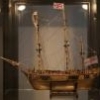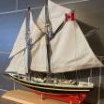-
Posts
596 -
Joined
-
Last visited
Reputation Activity
-
 Dziadeczek got a reaction from mtaylor in Byrnes Alternatives - Saw and Thickness Sander?
Dziadeczek got a reaction from mtaylor in Byrnes Alternatives - Saw and Thickness Sander?
I have a Proxxon FKS saw for more than 20 years now, and I am not complaining...
That's a very nice-looking thickness sander you made!
Vanda Lay Ind. makes a very similar sander, either with the motor attached to it or without (you can use a handheld drill or similar power source for it).
-
 Dziadeczek got a reaction from Ryland Craze in Byrnes Alternatives - Saw and Thickness Sander?
Dziadeczek got a reaction from Ryland Craze in Byrnes Alternatives - Saw and Thickness Sander?
I have a Proxxon FKS saw for more than 20 years now, and I am not complaining...
That's a very nice-looking thickness sander you made!
Vanda Lay Ind. makes a very similar sander, either with the motor attached to it or without (you can use a handheld drill or similar power source for it).
-

-
 Dziadeczek reacted to Ronald-V in HMS Sphinx 1775 by Ronald-V - Vanguard Models - 1:64
Dziadeczek reacted to Ronald-V in HMS Sphinx 1775 by Ronald-V - Vanguard Models - 1:64
Update:
The wales are now finished, painted as well as the thick strake above the wales. I cut the thick strake into pieces with a knife to make mounting easier. It consisted of 2 long pieces and that seemed quite difficult to get on properly in one go. So I cut these on the lasered planks and glued them on with PVA and CA. This went a lot easier (less stressful). Also painted the sides before mounting so that I didn't have to do this on the model anymore. The paint I used is "Gun metal black" from Admiralty paints. I first mixed some white and yellow through it to make it a bit grayer and duller, but when I had the first layer on I noticed that it looked a bit patchy. I think the Admiralty paints don't mix well with each other. But it didn't matter, I just painted it over with the standard color in the end. I think it looks good and you can still see the lasered planks shining through nicely.
The wales are a few tenths too high at the front and there is a small difference in symmetry at the stern. Too bad, but I can't worry about it too much haha
Glad I have these tricky things finished!
It makes the model a lot more finished and neater.
-
 Dziadeczek reacted to drobinson02199 in Bismarck by drobinson02199 - FINISHED - Amati - Scale 1:200
Dziadeczek reacted to drobinson02199 in Bismarck by drobinson02199 - FINISHED - Amati - Scale 1:200
Here's the rigging on the superstructure. Railings come next.
Regards,
David
-
 Dziadeczek got a reaction from michael101 in Mahogany vs walnut
Dziadeczek got a reaction from michael101 in Mahogany vs walnut
Neither one, in my opinion.
Why don't you try to use some fruitwood, like cherry, apple or pear. Much better...
-
 Dziadeczek reacted to threebs in Frigate USS United States 1789 by threebs - FINISHED - 1:72
Dziadeczek reacted to threebs in Frigate USS United States 1789 by threebs - FINISHED - 1:72
Except for rigging the anchors and stowing the ship's boats on their davits, all the running rigging I will be doing is done on the United States. Here I have finished the braces, and the fore and main yard clue and sheet lines. The ship's boats are next.
-
 Dziadeczek reacted to Quimp Slattery in Planking without clamps, clean up, or drying time - a new way to use Titebond Original
Dziadeczek reacted to Quimp Slattery in Planking without clamps, clean up, or drying time - a new way to use Titebond Original
During this week's modelling on HM Cutter Alert I accidentally stumbled on an unsuspected quality of Titebond Original wood glue - it can be made to set instantaneously with the application of heat. I brush uniform layers on the hull side and the pre-shaped plank and dry both rapidly with a hairdryer. This takes only a few seconds as the amount of glue we use is so small. Then I place the plank in position and apply heat with my soldering iron based, plank bending tool from Model Craft. This reactivates the glue and the two surfaces bond instantly and exactly in place, pressed firmly down by the iron. I work along the plank from one end to the other and it's fixed. No drying time required, no clamps, no squeeze-out to be cleaned up. It's better than contact or superglue because there's no accidental 'grab' in the wrong position. The glue which has soaked into the plank softens it slightly which makes getting it into place much easier. Previously I could set two planks in a session, now I can do a dozen, and I can do much longer runs without difficulty. In fact the only limit is my stamina. This has reduced the time required tremendously and since planking is such a large part of a build, it has reduced the overall time required very significantly indeed, perhaps even halving it. Use this method and build twice as many boats! Why didn't I see this before? I believe it's because I (and the modellers who have inspired me in books and on line) come to model shipbuilding from carpentry and assumed that clamping and drying time were unavoidable. Perhaps we read about how the original vessels were build from huge timbers and don't see that in our scaled down working we have more in common with marquetry or veneering? Having spent a week experimenting and working up a repeatable, efficient technique I belatedly searched YouTube for "Titebond" and "heat" to see whether anyone else had got there first. The link below will take you to a fairly authoritative source - The Official Titebond Channel. The guy is veneering a table but the techniques and chemistry are all valid. Significantly, I now have faith that the bond will be permanent, because Titebond says so.
I have not protected my planking (pear) with paper as the guy in the video suggests. I've had no scorching, just a little surface polishing which was easily removed when I sanded/scraped the hull that I had planked in less than a week.
I doubt that I'm the first model ship builder to find this 'new' way to use glue. I haven't seen it described anywhere else though so I thought it would be useful to mention it here. Unfortunately I have no financial interest in Titebond.
It probably works with other resin based wood glues, but I haven't tried any. Titebond also do a special purpose veneer glue which might be even more useful in ways of which I have not yet dreamed, but since Original works for me, I'll stick to it.
-
 Dziadeczek reacted to glbarlow in HMS Winchelsea 1764 by glbarlow - FINISHED - 1:48
Dziadeczek reacted to glbarlow in HMS Winchelsea 1764 by glbarlow - FINISHED - 1:48
Main Rail, Timbers, and Lower Rail - Chapter 12
It’s been a while, I took some time off for summer activities but that’s not the main reason for the delay between posts. I have to say solving the first part of chapter 12; the main rails, timbers and lower rail has been the most challenging and frustrating of my three year journey with Winchelsea.
The main rails themselves are a work of art, multi-dimensional and made from six laser cut pieces of multiple thicknesses they are fun to assemble (how @Chuck cuts this stuff so small, thin, and complex is beyond me) .
Shaping and fitting them isn’t overly difficult. I had very little luck with rubber cement, double sided tape or even Blu-Tac so mostly I just fumbled my way through, dropping them to the floor multiple times until I got it close. As I’d learn later I spent too much time on this and ended up having to make another set more conducive to the timber set-up. The main lesson is to have all the component parts complete before making too many adjustments on each alone. It’s not like this isn’t made clear in the monograph, I should listen better.
The timbers. Here is where my peace and harmony came to a crashing end. I made many timbers, my thanks to Chuck for sending me extra, I needed them. At first it seemed straight forward; use the provided jig, cut them, and stick them on add the upper rails after cutting some nice notches for the lower rail and move on. Timber, as it turned out, is not a work I want to hear again unless its related to falling trees.
Why you might ask is it not so simple as it may appear. Because there are many, many, many angles to account for and two sides to match on top of that. The rise of the main rail at the cat tail, the angle of all three timbers supporting the main rail from cat to stem, the notches in those timbers, which aren’t a lot of fun to cut, matching the curve of the lower rail with its run from bow to stem, and the lower rail fitting flush in the notches for the later to be added cover boards (note: I used an intentionally short piece of rail to first get the timber notches angled correctly).
At this point I quit taking photos. There are no new ones because I was doing the same thing over and over to get it right. I could have settled on 'good enough' a few times, I hadn’t done that yet so I wasn’t now. I would also like to point out that I skipped high school geometry class whenever possible.
Here’s what I learned - and again the monograph doesn’t hide this point, it emphasizes it - nothing can be done serially. It all has to be done as one big puzzle assembled all together before anything is installed. Eventually my one exception was fitting the center timber (after determining its angle on my hull wasn’t the same as the jig) and working out from there. Ultimately the bigger challenge was the lower rail. Also as I noted I wasn’t having a lot of luck with rubber cement and only limited success with my ever ready double sided tape, so fumbling fingers was my path forward. I considered installing a small trampoline below my work table so the many dropped parts would bounce back up into my hands. There was a lot of touch up painting needed at the end, some of it yet to be done in the photos.
I seem to be making a bigger point of this than I’ve seen in other logs so perhaps it’s just my ineptness, others must have found it far easier to complete. I just have to say for the first time I really didn’t enjoy the process and I’m glad it’s behind me. As they say, and I firmly put into practice, failure is the path forward to learning.
I did get there…eventually. Ultimately the rails are a signature look and a unique complement to the model. While it would have been nice it had been easier for me, it’s all worth it in the end.
I looked at my past models and more fully appreciate how Winchelsea’s main rail design is so next level. With all my whining in this post I’m very glad I took the time to do it as best I could, now I know so much more about angles on angles. My high school geometry teacher would be proud, if he could remember the guy supposed to be in the empty seat. Plus it’s not like the remaining steps of chapter 12 are going to be a walk in the park. So on with it.
Thanks for stopping by with your comments and likes.
-
 Dziadeczek got a reaction from mtaylor in Help with tapering
Dziadeczek got a reaction from mtaylor in Help with tapering
I would first start with carefully placing (glueing) a wale (levels taken from plans at each bulkhead), to establish points of reference. And only than I would subdivide the hull below this wale into symmetrical 'belts' using thin battens temporarily glued to the edges of bulkheads. Spaces above the wale generally don't need planks tapered, so tapering (spiling) applies to the hull below the wale.
-
 Dziadeczek reacted to OkesaBuilder in Okesa 1918 by OkesaBuilder - FINISHED - Scale 1:96 - Ferris Type WWI Wooden Steamer built in Portland Maine
Dziadeczek reacted to OkesaBuilder in Okesa 1918 by OkesaBuilder - FINISHED - Scale 1:96 - Ferris Type WWI Wooden Steamer built in Portland Maine
I was onto the final stages.
The rudder was modeled next. There was a dedicated plan of the rudder in contemporary Emergency Fleet Corporation plans from 1918. The rudder was built up as per those plans.
The propellor was modeled using a contemporary picture of the Ferris-type wooden steamship as well as other photos. The propellor was built-up from an applewood blank, shaped with the Foredom and hand-finished. Note that I made three propellors - to practice my carving technique.
As mentioned above I knew that I wanted to show the operations of cargo loading. For that I needed crates. I found online some 1917-1918 articles on crate building. I built the crates using that information.
Finally the model was ready to be mounted on its cherry baseboard. To make the model completely secure I used four applewood pedestals - two for the keel approximately in-line with the masts and one each 2 inches port and starboard of the keel amidships. Because of the low- and high-humidity in the winter and summer, respectively, where I live, I waited until the summer to mount the model (when the model, baseboard and case were most expanded). While the model is secure, there is also sufficient space for expansion and contraction of the model, baseboard and case with the weather.
I purchased a cherry case kit from Bluejacket Shipcrafters. The case was extensively modified using cherry lumber I had on hand. Each off the frame parts were separately painted with multiple coats of black paint (and wet-sanded between coats with 400-600 emery paper). The final coat was clear satin lacquer and then case was assembled. Museum quality/low glare acrylic was used for the panes.
Fin'
-
 Dziadeczek reacted to Rik Buter in Hooker Ship 82 ft. by Rik Buter - scale 1 : 64 - 1757 design Pieter Pauluszoon van Zwijndregt - first wooden ship build
Dziadeczek reacted to Rik Buter in Hooker Ship 82 ft. by Rik Buter - scale 1 : 64 - 1757 design Pieter Pauluszoon van Zwijndregt - first wooden ship build
I build some kind of main mast bitt. Often you see there are belaying pins in there but I am not sure if they are always suppose to. There is not much information about deck furniture on the drawing. The bitt might be a little too wide.
View of the bow at this stage.
Preparing the upper wales for the channels of the main mast. As I mentioned before, they were placed backwards on these type of vessels so the crew had more space along the bulwark to do the fishing. Each individual fisher was reeling in a long line with hooks attached.
I decided the main hatch is going to have a grating. I am not sure if fishing boats actually did have that. It was a good exercise though.
With the ledges and the battens.
I did not add camber to it nor to the coaming.
I placed the coaming right onto the beams and carlings according to a construction drawing I found here on MSW. Later on I found out that Dutch practise is different. They first do the deck planking, and than put the coaming on top of the deck. So this Dutch boat is going to have an American deck.
Here you see the beginning of the deck planking with the coamings put in first and also the mast partner of the main mast.
Best regards
-
 Dziadeczek got a reaction from PaddyO in Help with tapering
Dziadeczek got a reaction from PaddyO in Help with tapering
I would first start with carefully placing (glueing) a wale (levels taken from plans at each bulkhead), to establish points of reference. And only than I would subdivide the hull below this wale into symmetrical 'belts' using thin battens temporarily glued to the edges of bulkheads. Spaces above the wale generally don't need planks tapered, so tapering (spiling) applies to the hull below the wale.
-
 Dziadeczek got a reaction from Ronald-V in Help with tapering
Dziadeczek got a reaction from Ronald-V in Help with tapering
I would first start with carefully placing (glueing) a wale (levels taken from plans at each bulkhead), to establish points of reference. And only than I would subdivide the hull below this wale into symmetrical 'belts' using thin battens temporarily glued to the edges of bulkheads. Spaces above the wale generally don't need planks tapered, so tapering (spiling) applies to the hull below the wale.
-
 Dziadeczek got a reaction from N1ckel in Help with tapering
Dziadeczek got a reaction from N1ckel in Help with tapering
I would first start with carefully placing (glueing) a wale (levels taken from plans at each bulkhead), to establish points of reference. And only than I would subdivide the hull below this wale into symmetrical 'belts' using thin battens temporarily glued to the edges of bulkheads. Spaces above the wale generally don't need planks tapered, so tapering (spiling) applies to the hull below the wale.
-
 Dziadeczek got a reaction from JacquesCousteau in Help with tapering
Dziadeczek got a reaction from JacquesCousteau in Help with tapering
I would first start with carefully placing (glueing) a wale (levels taken from plans at each bulkhead), to establish points of reference. And only than I would subdivide the hull below this wale into symmetrical 'belts' using thin battens temporarily glued to the edges of bulkheads. Spaces above the wale generally don't need planks tapered, so tapering (spiling) applies to the hull below the wale.
-
 Dziadeczek got a reaction from Gregory in Help with tapering
Dziadeczek got a reaction from Gregory in Help with tapering
I would first start with carefully placing (glueing) a wale (levels taken from plans at each bulkhead), to establish points of reference. And only than I would subdivide the hull below this wale into symmetrical 'belts' using thin battens temporarily glued to the edges of bulkheads. Spaces above the wale generally don't need planks tapered, so tapering (spiling) applies to the hull below the wale.
-
 Dziadeczek got a reaction from mtaylor in Help with tapering
Dziadeczek got a reaction from mtaylor in Help with tapering
This line is NOT straight! Place a barrel horizontally on the ground and compare the run of it's staves against the flat ground. You'll see that they curve. The hull is similar to the open-ended barrel, so you'll have to properly shape (spile) each plank to fit into these gradually narrower and narrower toward the bow and stern, spaces.
-
 Dziadeczek got a reaction from N1ckel in Help with tapering
Dziadeczek got a reaction from N1ckel in Help with tapering
This line is NOT straight! Place a barrel horizontally on the ground and compare the run of it's staves against the flat ground. You'll see that they curve. The hull is similar to the open-ended barrel, so you'll have to properly shape (spile) each plank to fit into these gradually narrower and narrower toward the bow and stern, spaces.
-
 Dziadeczek got a reaction from tmj in Help with tapering
Dziadeczek got a reaction from tmj in Help with tapering
This line is NOT straight! Place a barrel horizontally on the ground and compare the run of it's staves against the flat ground. You'll see that they curve. The hull is similar to the open-ended barrel, so you'll have to properly shape (spile) each plank to fit into these gradually narrower and narrower toward the bow and stern, spaces.
-
 Dziadeczek got a reaction from Gregory in Help with tapering
Dziadeczek got a reaction from Gregory in Help with tapering
This line is NOT straight! Place a barrel horizontally on the ground and compare the run of it's staves against the flat ground. You'll see that they curve. The hull is similar to the open-ended barrel, so you'll have to properly shape (spile) each plank to fit into these gradually narrower and narrower toward the bow and stern, spaces.
-
 Dziadeczek got a reaction from GGibson in Help with tapering
Dziadeczek got a reaction from GGibson in Help with tapering
This line is NOT straight! Place a barrel horizontally on the ground and compare the run of it's staves against the flat ground. You'll see that they curve. The hull is similar to the open-ended barrel, so you'll have to properly shape (spile) each plank to fit into these gradually narrower and narrower toward the bow and stern, spaces.
-
 Dziadeczek got a reaction from FriedClams in La Créole 1827 by archjofo - Scale 1/48 - French corvette
Dziadeczek got a reaction from FriedClams in La Créole 1827 by archjofo - Scale 1/48 - French corvette
I might be wrong, but I think that if you use a solder wire, you are doing "soldering", but when you just heat the parts to join them (like for plumbing), you are '"welding " or "spot welding"...
Also, the units for welding are beefier than those for soldering, and so are the "tweezers".
Micromark sells the units for resistance soldering - quite pricey though!
Here is another video on fine resistance soldering:
-
 Dziadeczek got a reaction from mtaylor in La Créole 1827 by archjofo - Scale 1/48 - French corvette
Dziadeczek got a reaction from mtaylor in La Créole 1827 by archjofo - Scale 1/48 - French corvette
There are quite a few tutorials on the topic of Resistance Soldering on You Tube - just type the name on Google and find them.
Here are two of them:
Basically the principle is similar to the one of cutting Styrofoam with a hot wire - you utilize the feature of a high electrical resistance - in this case a special NiChrome wire, which, unlike a copper wire, resist the flow of electricity and instead heats the wire red hot.
For the Resistance Soldering you use a bit different electric current. The transformer changes your standard household current - in your case ~230 V/50 Hz, or in America 110 V/60Hz, into a low voltage, typically 2 or 3 Volts but very high Amperage, >15 A or so, and this gets the spot you want to solder very hot, but the areas immediately outside of it remain quite cool. So, you can solder this hot spot without accidentally desoldering neighboring sections, or - in your case, burning the wood of a block.
The trick is, to use a smallest possible electrode, some people use special tweezers, connected to a foot pedal that actuates the current flow.
Factory made units are quite expensive, so some modelers make their own from old transformers and fabricate their own tweezers. Apparently, it is quite possible...
-
 Dziadeczek got a reaction from mtaylor in La Créole 1827 by archjofo - Scale 1/48 - French corvette
Dziadeczek got a reaction from mtaylor in La Créole 1827 by archjofo - Scale 1/48 - French corvette
...The biggest problem is destroying the part with too much heat from the torch...
Probably fine resistance soldering would be helpful for these tight spots...










